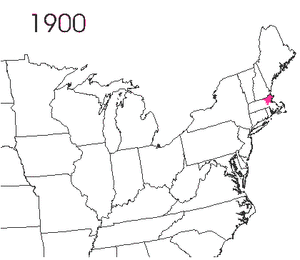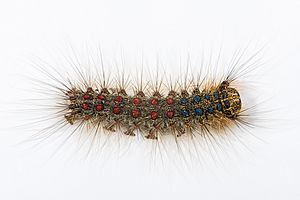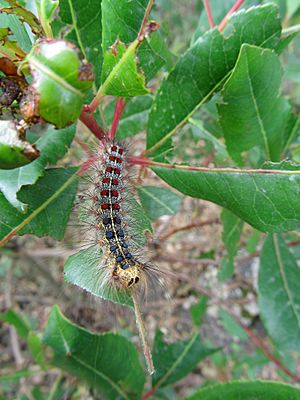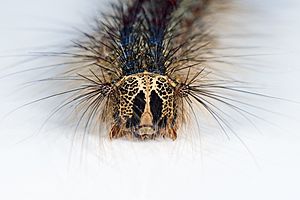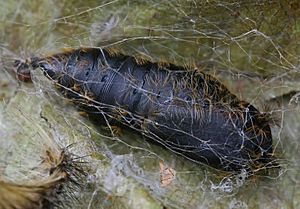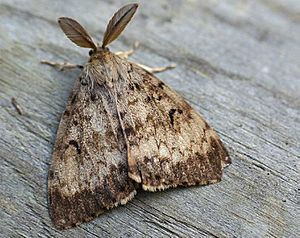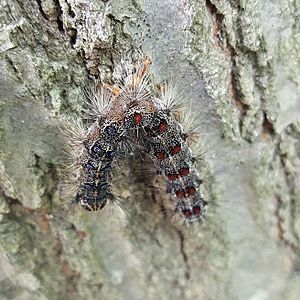North American gypsy moth facts for kids
Quick facts for kids North American gypsy moth |
|
|---|---|
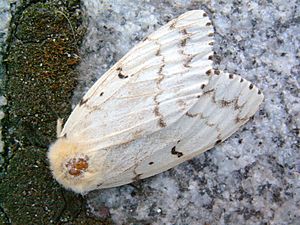 |
|
| Adult female | |
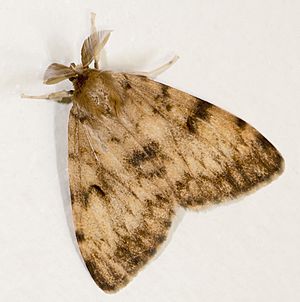 |
|
| Adult male | |
| Scientific classification |
|
| Kingdom: | Animalia |
| Phylum: | Arthropoda |
| Class: | Insecta |
| Order: | Lepidoptera |
| Superfamily: | Noctuoidea |
| Family: | Erebidae |
| Genus: | Lymantria |
| Species: | |
| Subspecies: |
L. d. dispar
|
| Trinomial name | |
| Lymantria dispar dispar (Linnaeus, 1758)
|
|
The Lymantria dispar dispar, often called the gypsy moth, is a type of moth from Europe and Asia. It belongs to the family Erebidae. These moths can be found across Europe, Africa, and North America.
Carl Linnaeus first described this species in 1758. Over the years, how scientists classify this moth has changed a lot. This has caused some confusion, and you might see it described in different ways. The gypsy moth is known as a pest because its larvae (caterpillars) eat the leaves of over 500 types of trees, bushes, and plants. It's one of the most damaging pests to hardwood trees in the eastern United States. In fact, it's listed as one of the 100 most harmful invasive species in the world.
Contents
About the Gypsy Moth
The gypsy moth, Lymantria dispar dispar, originally comes from Europe. It was brought to North America by accident. While the Asian and European moths weren't always seen as different types, they had clear differences even in the 1980s. In the UK, this moth was thought to be gone after 1900. However, new groups have been found in London since 1995 and in Buckinghamshire since 2005.
How it Came to North America
The European gypsy moth first arrived in North America in 1869. It quickly became an invasive species. A person named Étienne Léopold Trouvelot brought these moths over. He wanted to breed them with silk moths to start a new silk industry. But the moths accidentally escaped from his home in Medford, Massachusetts.
Reports differ on what happened next. Some say he warned officials about the escape, but no one helped. Others say he knew the risks and didn't tell anyone. Just ten years after their release, the gypsy moth was already a big problem. The first major outbreak happened in 1889. Trees lost all their leaves, and caterpillars covered houses and sidewalks. At first, no one knew what kind of insect was causing the damage. But after an expert identified the caterpillar, a program to get rid of them started in 1890. Eventually, they reached the Pacific Northwest. They invaded sometimes but haven't settled there because of successful pest control efforts.
How They Spread
Young gypsy moth larvae are very small and light. They can float in the air, carried by the wind. They spin silk threads and hang from them, waiting for the wind to blow them away. Their long hairs help them catch the wind. This natural spread is slow. However, people accidentally moving the moths has led to new groups popping up far away. For example, eggs are often carried on firewood. The United States Department of Agriculture says that without help, this pest spreads about 13 miles each year. A study from 2012 suggests that strong storms can make them spread faster. It's thought that strong winds carried larvae across Lake Michigan to Wisconsin, a distance of at least 50 miles.
To stop the spread, people try to limit how firewood is moved. This is because moths often lay their eggs on dead wood.
Life Cycle of the Gypsy Moth
The gypsy moth goes through four main stages: egg, larva (caterpillar), pupa, and adult moth.
Eggs
Gypsy moth egg masses are usually found on tree branches and trunks. But they can also be in other hidden spots like rocks, leaves, or even on cars. Female gypsy moths cannot fly. So, they lay their eggs on a surface close to where they hatched from their pupa. The eggs are covered with a layer of hairs. This hairy covering protects the eggs from animals that might eat them and from parasites. It also helps keep the eggs warm in cold weather and keeps moisture inside.
The tiny larva inside the egg grows fully in about one month after the eggs are laid. Then, it stops growing and waits through the winter. This resting stage lasts for about eight or nine months. The larva inside the egg gets rid of some of its water content. This helps the eggs survive freezing temperatures. In the spring, the larva inside the egg becomes active again and takes in water. Then, the larva chews its way out of the egg and through the protective hair of the egg cluster.
Egg clusters are usually oval-shaped, about 3/4 inch wide and 1 1/2 inches long. They are a yellowish-brown color, like a manila folder. But they can become lighter over the winter. As the female lays the eggs, she covers them with hair-like bristles from her body. Each egg cluster can hold from 100 to 1000 eggs. Because of how the eggs look, they have common names like "fungus spinner" (from German) or "the spongy one" (from French).
Larvae (Caterpillars)
Caterpillars hatch from the egg masses in the spring. Most larvae hatch within a week, but some can take up to a month. New larvae stay on or near the egg cluster if it's rainy or if the temperature is below 7 °C. The larvae will spread out even if there's enough food. They hang from silk threads, waiting for the wind to carry them away. When they first hatch, larvae are about 3 mm long. They will grow to be 50 to 90 mm long.
Young larvae first eat the tiny hairs on leaves, then move on to the leaf surface. They eat during the day, mostly in the morning and late afternoon. As they grow, they start eating at night. When not eating, larvae stay on the underside of leaves. They make a silk mat to hold onto.
To grow, larvae must shed their skin (molt). The term instar describes how many times a larva has molted. For example, a first-instar larva hasn't molted yet. Males usually go through five instars, and females go through six. When larvae reach the fourth instar, they start eating at night. They return to their hiding spots at dawn. These spots can be under bark, in cracks, or under branches – any place that offers protection.
Newly hatched larvae are black with long, hair-like bristles. Older larvae have five pairs of raised blue spots and six pairs of raised brick-red spots along their backs. They also have many bristles. As the caterpillar stage ends, they stop eating. They then surround themselves in a loose silk net.
How to Spot a Gypsy Moth Caterpillar
You can tell gypsy moth caterpillars apart from others by their unique spots. Near their head, they have five pairs of blue spots. Towards their tail, they have six pairs of red spots. This helps avoid confusing them with other caterpillars like the spiny elm caterpillar. Tent caterpillars, for example, build silky tents in trees, have a stripe on their back, and prefer cherry trees.
Pupae
Caterpillars become fully grown between mid-June and early July. Then, they enter the pupal stage. During this time, the larvae change into adult moths. This pupation stage lasts for 14 to 17 days. The adult moth will then emerge by splitting the pupal skin.
When there are not many moths around, pupation happens in hidden spots. These include under bark, in cracks, under branches, or on the ground. But when there are many moths, pupation can happen anywhere. This includes open spots, even on tree trunks or on leaves of trees they don't usually eat. Caterpillars often make flimsy cocoons from silk strands that hold leaves together. Others don't cover their pupae at all. Instead, they hang from a twig or tree bark, much like butterfly pupae.
Adults
Male gypsy moths have feathery antennae, while females have thin ones. Females are also larger than males. A male moth's front wing is 20–24 mm long, but a female's is 31–35 mm long. Another key difference is that female moths have fully formed wings but cannot fly. Female flight is common in Europe and Asia, but these might be a different type of moth, called the Asian gypsy moth.
Moths usually come out of their pupae in July. This can change depending on how many moths there are and the weather. The brown male gypsy moth usually emerges a day or two before the females. Males fly in fast zigzag patterns, but they can also fly straight. Like most moths, males are usually active at night, but sometimes they fly during the day. Males fly up and down tree trunks or other tall objects looking for females.
When the heavy, egg-filled females emerge, they release a special scent called a pheromone. This scent attracts the males. The female has a small gland at the end of her body that releases the pheromone with a pumping motion, which is called "calling." This scent can attract males from far away. Males follow the scent with their zigzag flight.
Mating is simple: the female lifts her wing so the male can connect with her. They stay together for up to an hour, but the sperm transfer usually takes about 10 minutes. One male moth can mate with more than one female. Females can mate multiple times, but it's not common. This is because the female stops releasing the attracting pheromone after mating. After mating, females start laying their eggs.
Adult moths live for about one week. They don't have a working digestive system, so they can't eat. But they can drink water. Females can attract males for about two days. The pheromone scent becomes weaker by the third day. Because the pheromone is so strong, most females will mate.
Females lay their eggs on trees, bushes, rocks, vehicles, and many types of plants. Each female typically lays about 500 eggs. The eggs are covered with a fuzzy, peach-colored fuzz. This fuzz can cause a serious rash if it touches bare skin or fur.
Gypsy Moth Behavior
Many things in nature affect how gypsy moths behave. These include how much food is available, how many predators are around, and how much competition there is for mates. A group of gypsy moths will stay small for many years. But then, the population can suddenly grow very quickly, becoming an "outbreak." After a few generations, the population will drop back down.
Feeding Habits
The gypsy moth causes a lot of damage by eating the leaves off deciduous trees (trees that lose their leaves in the fall) in the Northern Hemisphere. Since it was brought to the United States in 1868 or 1869, it has spread across most of the hardwood forests in the eastern United States and Canada. Over three hundred types of trees and bushes are food for the gypsy moth.
Caterpillars will climb up anything in their way to find food.
Favorite Foods (Hosts)
Gypsy moth caterpillars prefer oak trees. But they can eat the leaves of many kinds of trees and bushes, both hardwood and conifer (evergreen). In the eastern US, they like leaves from oaks, aspen, apple, sweetgum, speckled alder, basswood, gray birch, paper birch, poplar, willow, and hawthorns. Older caterpillars will eat some types of softwood that younger ones avoid. These include cottonwood, hemlock, Atlantic white cypress, and eastern pine and spruce trees.
The gypsy moth usually avoids ash trees, tulip-tree, American sycamore, butternut, black walnut, catalpa, flowering dogwood, balsam fir, cedar, American holly, mountain laurel, and rhododendron bushes. However, if there are a huge number of caterpillars, they will eat these trees too in their later stages.
Predators and Parasites
Many animals eat L. dispar. Some, like the white-footed mouse or the wasp Anastaus disparis, have a big effect on how many gypsy moths there are. Birds and other insects that eat gypsy moths usually have only a small effect on their numbers.
Small Mammals
The white-footed mouse, Peromyscus leucopus, is very important for controlling small gypsy moth populations. These rodents eat caterpillars and pupae that hide near or on the ground. The white-footed mouse is the most common small mammal in the northeastern US. The Northern short-tailed shrew also eats gypsy moth larvae and pupae.
Birds
Birds that eat insects will prey on gypsy moth larvae. However, the egg clusters are protected by their hairy coverings. When there are many gypsy moths, birds don't have a big effect on the total population. Birds that eat gypsy moth larvae, pupae, and adults include the blue jay, red-eyed vireo, eastern towhee, northern oriole, catbird, and the European robin. The black-capped chickadee eats the moth at all stages of its life, even the eggs.
Other Insects (Invertebrate Predation)
Calosoma sycophanta is a type of beetle that eats gypsy moth larvae and pupae. Both the beetle larvae and adults tear open their prey and feed on them.
Parasites
Many studies have looked at insects that live on or in gypsy moths (parasitoids). But these usually don't have a major effect on the gypsy moth population.
Four types of parasitic flies attack gypsy moth larvae. Some lay an egg on the larva. If the fly egg hatches before the gypsy moth larva sheds its skin, the fly larva will go inside the host. Other flies pierce the gypsy moth larva and lay their own larvae inside. Another type lays its eggs on leaves. The gypsy moth larva eats the egg, and the fly larva hatches inside its gut.
Eight types of parasitic wasps attack the gypsy moth. Some wasps attack the eggs. One type, Ooencyrtus kuvanae, attacks the eggs, but it can only reach the eggs on the surface of the cluster. Another, Anastatus disparis, has limited success because it can only attack eggs that haven't started developing yet, and the female wasps don't have wings. Even so, Anastatus disparis is the only species known to sometimes affect how many gypsy moths there are. Other wasps attack the early caterpillar stages or the pupae.
A parasite from North America, Itoplectes conquisitor, attacks and kills gypsy moth pupae. However, the parasite larvae rarely develop inside the host, and there aren't many attacks.
Diseases (Pathogens)
Gypsy moth populations in different places can get sick from different viruses. The most important disease is the Lymantria dispar multicapsid nuclear polyhedrosis virus (LdMNPV), also called NPV. If larvae eat viral particles when they hatch from the egg, they will die in their first stage. Their bodies break apart, spreading the virus on leaves. Other larvae then eat these leaves. Outbreaks of this virus cause many larvae to die. The smell of the decaying larvae fills the air. This disease is even used as an insecticide called Gypchek.
Another disease-causing germ, Steptococcus faecalis, also causes many larvae to die. Larvae killed by this germ look shriveled.
Fungi
Entomophaga maimaiga is a Japanese fungus that helps control gypsy moth populations. It was first brought to North America around 1910. But it didn't become an effective control until the 1980s.
Other Adaptations
How many larvae are in an area greatly affects their behavior. If there are few larvae, they stay still during the day. But if there are many, they become very active.
Mating between closely related moths can cause problems with their genes. Spreading out helps reduce this problem.
Weather Effects
Temperature is very important for the gypsy moth. Very low temperatures can kill them. They can survive temperatures of −9 °C in winter. But a long period of cold, or even a short time at −23 °C, will kill the larvae inside the eggs. Egg masses laid low or on the ground can be protected by snow. This helps them survive deadly cold temperatures. Temperatures above 32 °C help them grow and develop faster. Heavy rainfall during the caterpillar stage can drown larvae before they are settled. So, fewer moths are seen after heavy rains. Wind is also key for spreading larvae. Winds of just a few miles per hour are strong enough to break the silk threads and carry the larvae away.
Pheromones
A man-made version of the gypsy moth's scent, called Disparlure, has been created. It's used to confuse male moths so they can't find females, or to lead them into traps. However, this method works less well when there are many moths. So, it's mainly used to slow down an infestation until other natural solutions can be found.
Impact of the Gypsy Moth
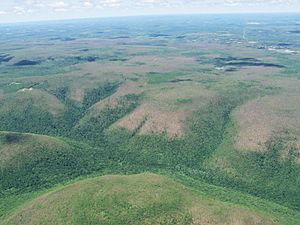
The gypsy moth lives in the same areas as the northern tiger swallowtail butterfly, Papilio canadensis. Studies show that gypsy moth diseases and body fluids can harm swallowtail larvae. Gypsy moth body fluid is deadly. Swallowtail caterpillars were also more likely to be attacked by parasites when they were near gypsy moth outbreaks.
Lymantria dispar dispar causes widespread loss of leaves on trees. This costs the economy millions of dollars in damages. From 1970 to 2010, gypsy moths defoliated (ate the leaves off) 80.4 million acres in America. The worst year was 1981, with 12.9 million acres defoliated. In 2010, 1,207,478 acres were defoliated.
When gypsy moths strip trees of their leaves each year, it affects forest birds. Birds nesting in defoliated areas were more likely to have their nests attacked by predators. So, gypsy moths directly impact how birds behave in American forests.
Gypsy Moth Rash
Some people have reported getting a rash similar to poison ivy when they touch the hairs of the gypsy moth caterpillar. This can happen from direct contact or if the tiny hairs are carried by the wind onto skin or clothing. Gypsy moth rashes were first reported in the early 1980s. This was during a large outbreak in the Northeastern United States. In coastal Maine and Cape Cod, Massachusetts, rashes caused by caterpillars are more often from the brown-tail moth (Euproctis chrysorrhoea).
See also
 In Spanish: Lagarta peluda para niños
In Spanish: Lagarta peluda para niños


